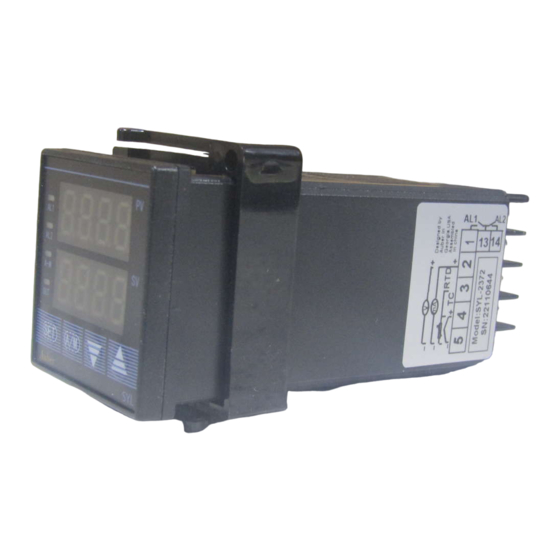温度コントローラー Auber Instruments SYL-2372のPDF 取扱説明書をオンラインで閲覧またはダウンロードできます。Auber Instruments SYL-2372 8 ページ。

AUBER INSTRUMENTS
Instruction Manual
Caution
• This controller is intended to be used with proper safety equipment under
normal operating conditions. Failure or malfunction of the controller may
result in personal injury or damage to the equipment or other property,
devices (limit or safety controls) or systems (alarm or supervisory) intended
to warn of or protect against failure or malfunction of the controller. To
prevent harm to you and to the equipment, this item must be incorporated
into and maintained as a part of the control system under the appropriate
environment.
• Installing the rubber gasket supplied will protect the controller front panel
from dust and water splash (IP54 rating). Additional protection is needed for
higher IP rating.
• This controller carries a 90-day warranty. This warranty is limited to the
controller only.
1. Specifications
Input type
Thermocouple (TC): K, E, S, N, J, T, B, WRe5/ 26;
RTD (Resistance Temperature Detector): Pt100, Cu50
DC Voltage: 0~5V, 1~5V, 0~1V, -100~100mV, -
20~20mV, -5~5V, 0.2~1V
DC current: 0~10mA, 1~10mA, 4~20mA. (Use external
shunt resistor for higher current)
Input range
Please see section 4.7 for detail.
Accuracy
± 0.2% Full scale: RTD, linear voltage, linear current and
thermocouple input with ice point compensation or Cu50
copper compensation.
0.2% Full scale or ± 2 ºC: Thermocouple input with
internal automatic compensation.
Note: For thermocouple B, the measurement accuracy of
± 0.2% can only be guaranteed when input range is
between 600~1800 ºC.
Response time
≤ 0.5s (when FILt = 0)
Display resolution 1° C, 1° F; or 0.1° C
Control mode
Fuzzy logic enhanced PID control
On-off control
Manual control
Output mode
Zero crossing SSR, 100-400VAC/2A
Alarm output
Relay contact (NO): 250VAC/1A, 120VAC/3A, 24V/3A
Alarm function
Process high alarm, process low alarm, deviation high
alarm, and deviation low alarm
Manual function
Automatic/Manual bumpless transfer
Power supply
85~260VAC/50~60Hz
Power
≤ 5 Watt
consumption
Ambient
0~50ºC, 32~122ºF
temperature
Dimension
48 x 48 x 100mm (W x H x D)
Mounting cutout
45 x 45mm
2. Available Configurations
All the models listed in Table 1 are 1/16 DIN size with dual-alarm outputs.
2021.06
SYL-2372 PID TEMPERATURE CONTROLLER
INSTRUCTION MANUAL
Version 1.7 (June 2021)
Table 1. Controller models.
Model
Output mode
SYL-2372
Zero crossing SSR
SYL-2372P
Zero crossing SSR
3. Terminal Wiring
Figure 1. Wiring diagram.
3.1 Sensor connection
Please refer to Table 3 for the input sensor type (Sn) setting codes. The initial
setting for input is for a K type thermocouple. Set Sn to the right sensor code if
another sensor type is used.
3.1.1 Thermocouple
The thermocouple should be connected to terminals 4 and 5. Make sure that
the polarity is correct. There are two commonly used color codes for the K type
thermocouple. US color code uses yellow (positive) and red (negative).
Imported DIN color code uses red (positive) and green/blue (negative). The
temperature reading will decrease as temperature increases if the connection
is reversed.
When using ungrounded thermocouple that is in touch with a large conductive
subject, the electromagnetic field picked up by the sensor tip might be too large
for the controller to handle, the temperature display will change erratically. In
that case, connecting the shield of thermocouple to terminal 5 (circuit ground of
the controller) might solve the problem. Another option is to connect the
conductive subject to terminal 5.
3.1.2 RTD sensor
For a three-wire RTD with standard DIN color code, the two red wires should
be connected to the terminals 3 and 4. The white wire should be connected to
terminal 5. For a two-wire RTD, the wires should be connected to terminals 4
and 5. Jump a wire between terminals 3 and 4. Set controller input type, Sn to
21.
3.1.3 Linear input (V, mV, mA or resistance)
V and mA current signal inputs should be connected between terminals 2 and
5. Terminal 2 is positive. mV signal inputs should be connected between
terminals 4 and 5. Terminal 4 is positive. For resistance inputs, short terminals
3 and 4, then connect resistance inputs between terminals 4 and 5.
3.2 Power to the controller
The power cables should be connected to terminals 9 and 10. Polarity does not
matter. This controller can be powered by 85-260V AC power source. Neither a
transformer nor jumper is needed to wire it up. For the sake of consistency with
the wiring example described later, we suggest you connect the hot wire to
terminal 9 and neutral to 10.
WWW.AUBERINS.COM
Ramp/soak option
No
Yes
P1/8
